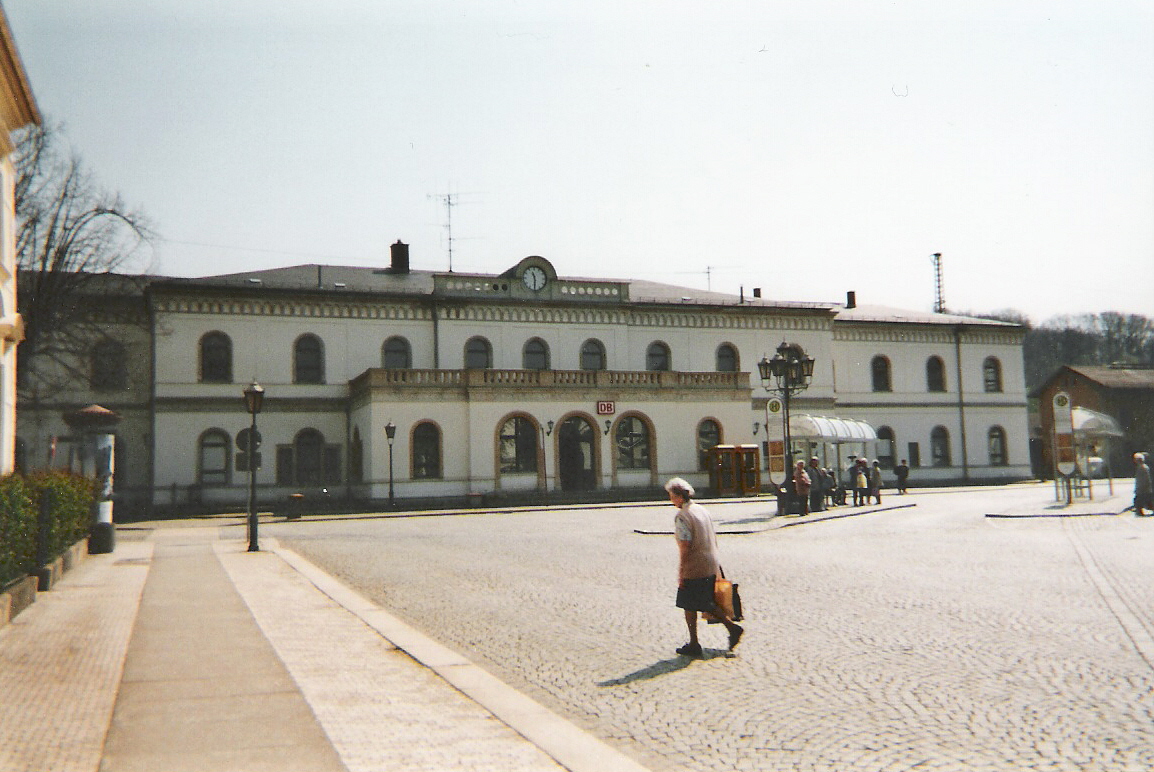|
Crimmitschau Station
Crimmitschau station is a station on the Leipzig–Hof railway in the German state of Saxony. It is the only station in the town of Crimmitschau. History Work started on the Leipzig–Hof railway in 1841 and Crimmitschau already had a simple station with the opening of the 28.73 km-long Altenburg–Crimmitschau section on 15 March 1844. The Leipzig–Hof line was completed in 1851. A new station building was opened in 1873, which is characterised by its impressive architectural style. It is still used for housing railway workers and part of the building is used as a restaurant. The first passenger subway, which was an underpass to the second platform, was built in 1888. A and subway with concrete floors was built in 1979. By the end of the nineteenth century, it was becoming increasingly apparent that the station had reached the limit of its capacity. Since the location did not allow for a third track, the construction of a freight yard in the district of Wahl w ... [...More Info...] [...Related Items...] OR: [Wikipedia] [Google] [Baidu] |
Crimmitschau
Crimmitschau () is a town in the district of Zwickau in Saxony, Germany. Geography Crimmitschau lies on the river Pleiße in the northern foothills of the Erzgebirge. Neighboring municipalities Adjacent communities include: Zwickau, Dennheritz, Neukirchen, Meerane, and Langenbernsdorf in Landkreis of Zwickau; Heyersdorf, Jonaswalde, Ponitz and Thonhausen in Thuringian Landkreis of Altenburger Land; as well as Braunichswalde, Rückersdorf, and Seelingstädt in Thuringia in Landkreis of Greiz. Municipality subdivisions The town Crimmitschau consists of Crimmitschau proper and the following five ''Ortschaften'' (localities), each containing several ''Ortsteile'' or divisions:Hauptsatzung der Großen Kreisstadt Crimmitschau January 2019. * [...More Info...] [...Related Items...] OR: [Wikipedia] [Google] [Baidu] |
German Gold Mark
The German mark (german: Goldmark ; sign: ℳ) was the currency of the German Empire, which spanned from 1871 to 1918. The mark was paired with the minor unit of the pfennig (₰); 100 pfennigs were equivalent to 1 mark. The mark was on the gold standard from 1871–1914, but like most nations during World War I, the German Empire removed the gold backing in August 1914, and gold and silver coins ceased to circulate. After the fall of the Empire due to the November Revolution of 1918, the mark was succeeded by the Weimar Republic's mark, derisively referred to as the Papiermark ("Paper mark") due to hyperinflation in the Weimar Republic from 1918–1923. History The introduction of the German mark in 1873 was the culmination of decades-long efforts to unify the various currencies used by the German Confederation.pp 205-218 https://books.google.com/books?id=GrJCAAAAIAAJ&pg=PA205#v=onepage&q&f=false The Zollverein unified in 1838 the Prussian and South German currenc ... [...More Info...] [...Related Items...] OR: [Wikipedia] [Google] [Baidu] |
Railway Stations In Germany Opened In 1873
Rail transport (also known as train transport) is a means of transport that transfers passengers and goods on wheeled vehicles running on rails, which are incorporated in tracks. In contrast to road transport, where the vehicles run on a prepared flat surface, rail vehicles (rolling stock) are directionally guided by the tracks on which they run. Tracks usually consist of steel rails, installed on sleepers (ties) set in ballast, on which the rolling stock, usually fitted with metal wheels, moves. Other variations are also possible, such as "slab track", in which the rails are fastened to a concrete foundation resting on a prepared subsurface. Rolling stock in a rail transport system generally encounters lower frictional resistance than rubber-tyred road vehicles, so passenger and freight cars (carriages and wagons) can be coupled into longer trains. The operation is carried out by a railway company, providing transport between train stations or freight customer faciliti ... [...More Info...] [...Related Items...] OR: [Wikipedia] [Google] [Baidu] |


